10 employee performance review templates for effective evaluations

Building high-performing teams is the No. 1 priority for 62% of CEOs, according to Leapsome’s 2025 HR Insights report.* After all, strong teams bring about better decision-making, faster execution, and higher retention, all of which directly support long-term business performance.
At the same time, HR leaders now prioritize creativity, innovation, and task completion as the top drivers progress in the workplace.* That means HR and leadership are aligned on outcomes, but often struggle to track the very qualities they value most. This is especially true if your performance reviews default to surface-level metrics like hours tracked or rely on hoc feedback.
Regular, individualized review and feedback cycles are therefore key to unlocking key capabilities and insights — but how do you ensure managerial input is constructive without being demotivating? What questions should you ask to encourage employee participation in the review process? And how do you tailor each review to individual employees while maintaining a standardized approach across your team?
A well-designed employee performance review template is the simplest way to bring structure without sacrificing personalization.
Below you’ll find 10 best-practice templates you can download and adapt to any situation, so you can run review cycles that are actionable, focused on growth, and aligned with your business goals.
🌟 Start setting up your performance reviews today
Our free employee performance review template is packed with best-practice questions to help you do reviews correctly.
👉 Download it now
* Leapsome, 2025
10 free, downloadable performance review templates
Performance reviews are more effective when they combine structured cycles with input from multiple sources. That’s why 360° reviews — where you gather feedback from peers, direct reports, and managers — is so effective at building a complete picture of employee performance.
The templates below support that approach. Whether you run monthly check-ins, biannual reviews, or probation assessments, each one offers a clear structure you can adapt to your team’s workflow and goals.
1. Annual performance review template

About annual performance reviews
Annual performance reviews provide a formal, comprehensive assessment of employee performance. They’re often used to inform compensation decisions and long-term development planning, and provide upward feedback.
When/Why use an annual performance review template
Use this template when conducting end-of-year evaluations that feed into goal-setting, promotions, or bonus discussions. It’s best suited to companies with stable, long-term roles and established review processes.
💡 Download the annual performance review template
2. Biannual performance review template

About biannual performance reviews
Biannual reviews support development planning and give teams the chance to assess progress, address blockers, and adjust priorities.
When/Why use a biannual performance review template
Use this template if you want to focus on continuous improvement, especially where goals and priorities shift throughout the year.
💡Download the biannual performance review template
3. Quarterly performance review template
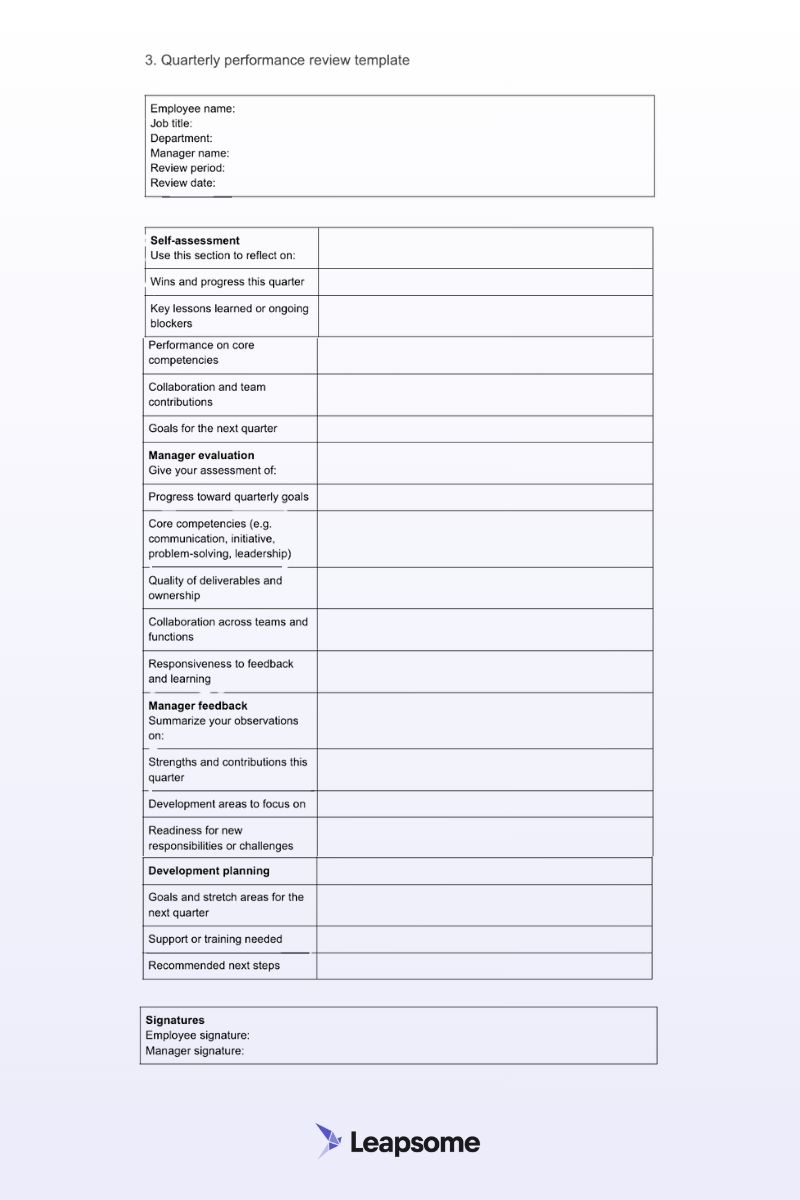
About quarterly performance reviews
Quarterly reviews help you catch misalignment early, reinforce key values, and support short-cycle goal tracking.
When/Why use a quarterly performance review template
Use this template to drive continuous improvement in fast-moving teams where priorities often change.
💡Download the quarterly performance review template
4. Monthly performance review template

About monthly performance reviews
Monthly reviews create space for frequent, lightweight check-ins to surface issues early, track short-term goals, and give timely support.
When/Why use a monthly performance review template
Use this template if you want to focus on continuous improvement, especially where employees can benefit from additional support.
💡Download the monthly performance review template
5. Self-assessment performance review template
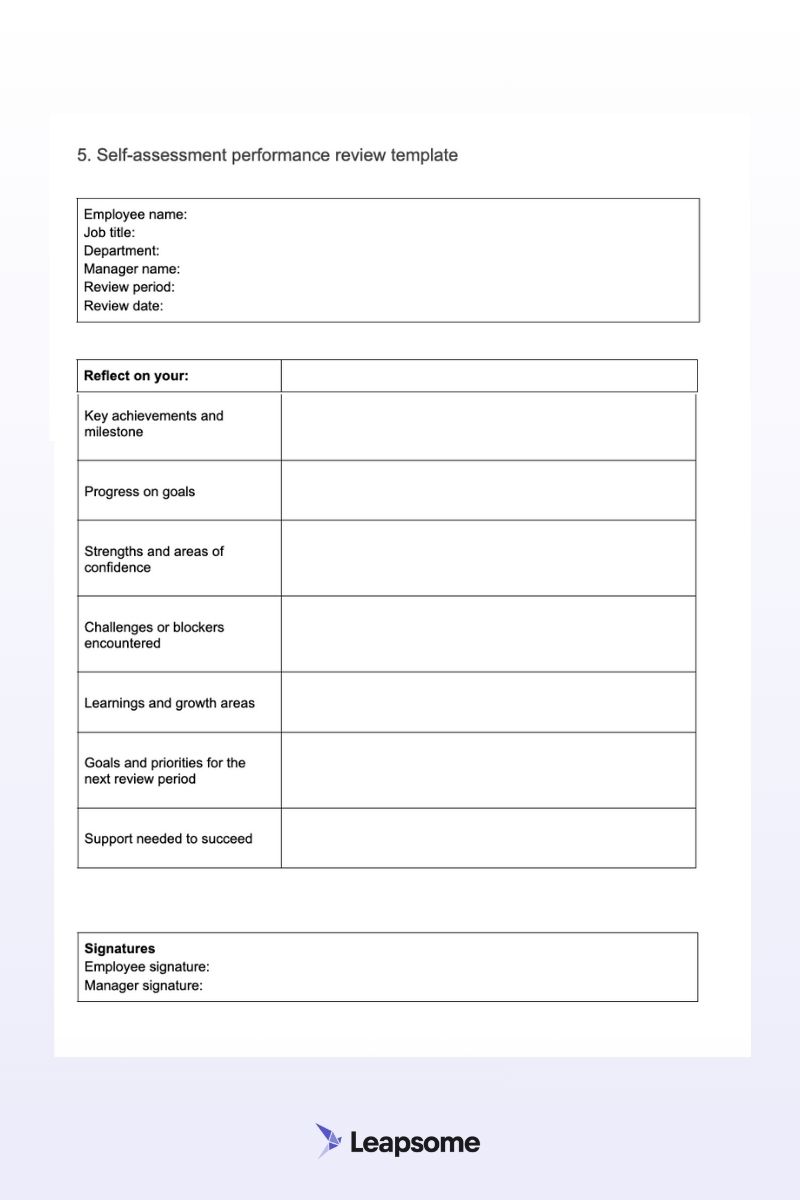
About self-assessment performance reviews
Self-assessments give employees space to reflect on their achievements, challenges, and development needs, which helps them take ownership of their growth.
When/Why use a self-assessment performance review template
Use this template as part of a broader review cycle to encourage self-awareness, align expectations, and support more balanced, two-way conversations.
💡Download the self-assessment performance review template
6. Manager performance review template
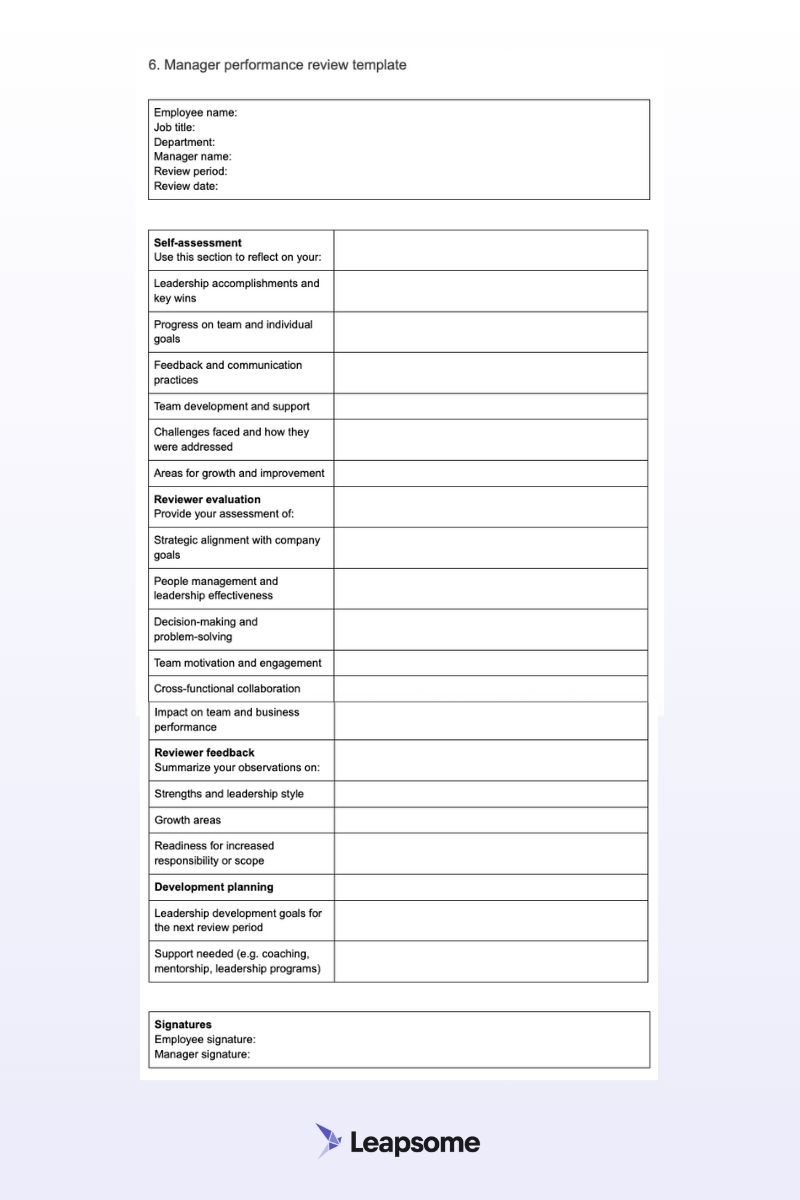
About manager performance reviews
Manager performance reviews focus on leadership behaviors, communication, and team support. They’re essential for understanding how managers are enabling performance and development across their teams.
When/Why use a manager performance review template
Use this template to evaluate and support your managers’ impact on team performance, morale, and long-term growth — especially as your organization scales.
💡Download the manager performance review template
7. Peer performance review template
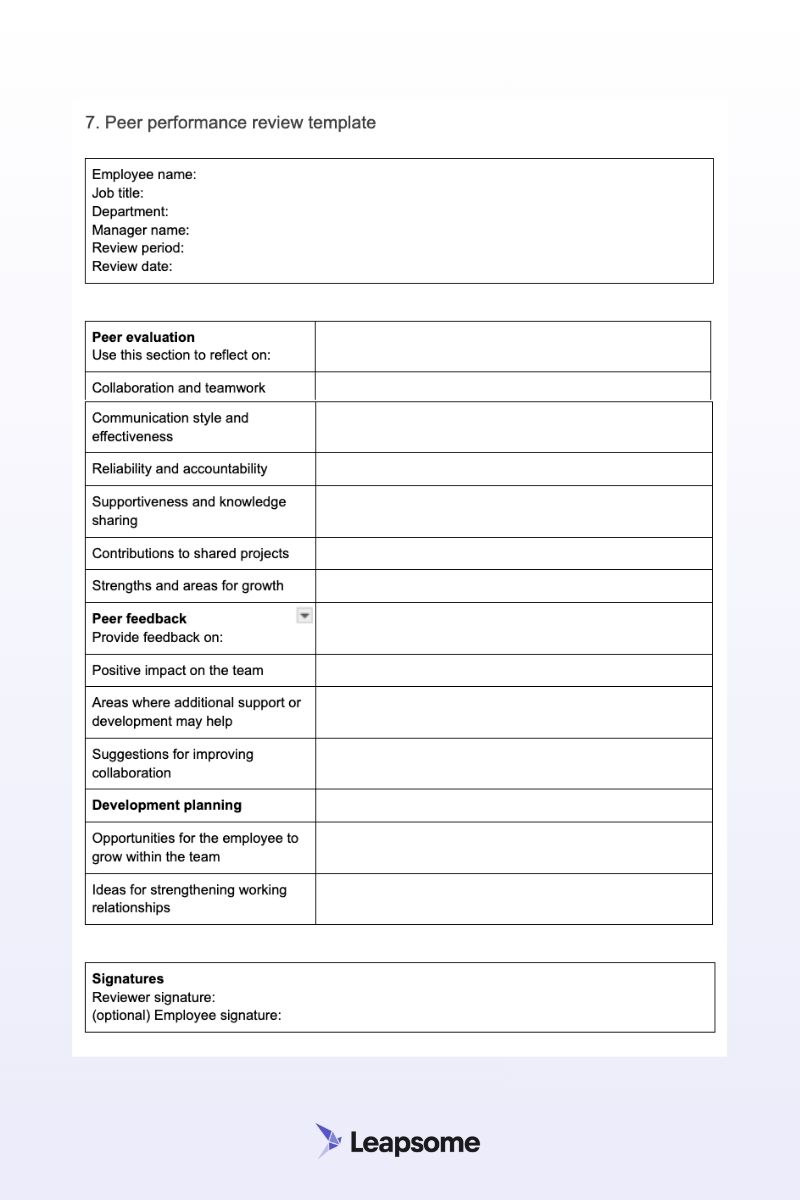
About peer performance reviews
Peer reviews offer insight into how team members collaborate, communicate, and contribute to group outcomes. They help bring about feedback that managers may struggle to provide.
When/Why use a peer performance review template
Use this template when you want to capture well-rounded feedback during review cycles or as part of a 360° review process. It's especially useful for assessing teamwork, reliability, and interpersonal dynamics.
💡Download the peer performance review template
8. New employee performance review template
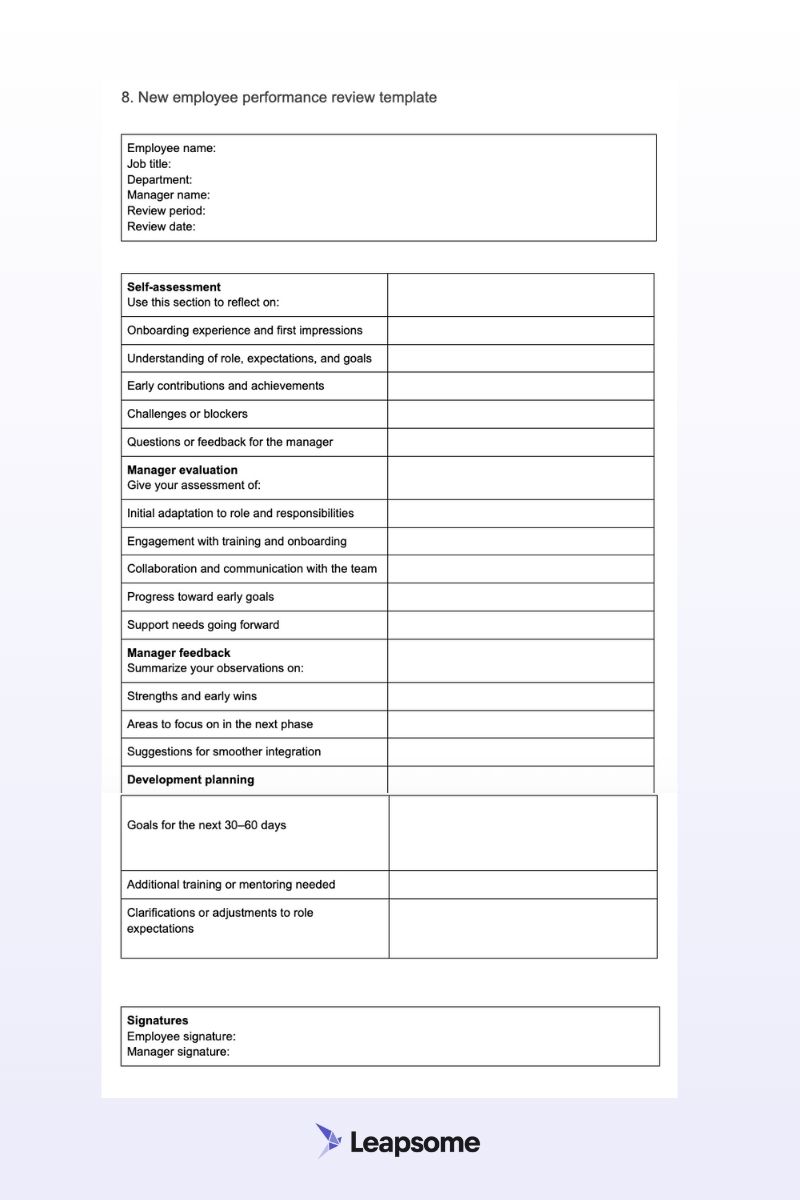
About new employee performance reviews
New employee reviews help managers assess early contributions, clarify expectations, and identify onboarding gaps. They also give new hires a chance to reflect and ask for support early on.
When/Why use a new employee performance review template
Use this template at the end of an onboarding period or during early check-ins to evaluate progress, reinforce alignment, and set up the employee for long-term success.
💡Download the new employee performance review template
9. 90-day performance review template
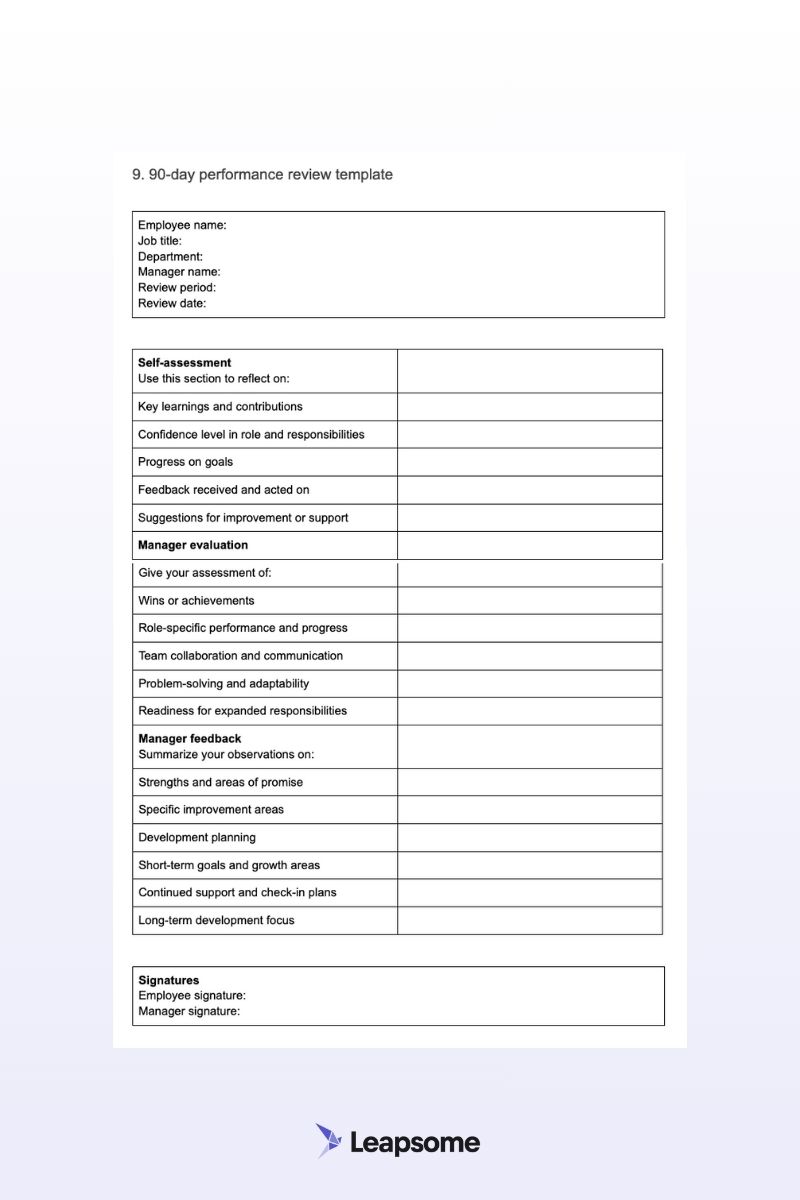
About 90-day performance reviews
A 90-day review is a milestone check-in to assess how well a new hire is adapting to their role. It focuses on progress, early contributions, and flags any issues before they escalate.
When/Why use a 90-day performance review template
Use this template to evaluate new hires after their first three months. It helps managers provide targeted feedback, reinforce expectations, and plan next steps for development or support.
💡Download the 90-day performance review template
10. Probation period performance review template

About probation period performance reviews
Probation reviews assess whether a new hire is meeting expectations during their initial period of employment. They focus on performance, team fit, and areas for support or improvement before confirming permanent employment.
When/Why use a probation period performance review template
Use this template toward the end of a probationary period to guide final decisions, align on expectations, and set a clear direction for continued success or course correction.
💡Download the probation period performance review template
What to include in performance review templates
Whether you’re creating a review template from scratch, adapting our examples, or building your template with dedicated review software, make sure you incorporate the following performance review elements to be fair, consistent, and effective.
Goals & objectives
The most effective goals for performance reviews are individual ones — goals the employee has direct control over and can reasonably influence.
Avoid including team or cross-functional OKRs in individual reviews, as employees often have limited influence on shared objectives. Being evaluated on them can be demoralizing.
That said, individual goals should still align with broader company objectives. For example:
- A customer service rep might aim to resolve X% of issues within 24 hours
- Their individual goal contributes to a larger company objective like improving customer satisfaction or loyalty
To maintain alignment:
- Use a goal tree to show how personal objectives connect to team and company goals
- Check in on goal progress regularly throughout the review cycle, not just at the end
Core competencies
Employees should be evaluated against the specific competencies required for their role. To keep this consistent and fair. Use a structured competency framework that includes:
- Company-wide skills (e.g. communication, collaboration)
- Team-specific skills (e.g. agile workflows, stakeholder management)
- Role-specific skills (e.g. Python for engineers, SEO strategy for marketers)
Your review should cover:
- Technical skills (e.g. writing, data analysis, product knowledge)
- Soft skills (e.g. leadership, teamwork, adaptability, communication)
Use the review to reflect on:
- Competencies the employee has strengthened
- Skills they need to build to progress or meet development goals
Achievements & wins
Recognizing achievements is essential to building a full picture of any team member’s work, so it should be a key part of any employee evaluation template.
Regular recognition also reinforces alignment — something 3 in 4 HR leaders say is undermined by workplace division, limiting their ability to drive business impact and build resilience.
Make it a habit to highlight:
- Projects completed successfully
- Sales, performance, or support targets hit
- Positive client or team feedback
- Internal contributions that helped others succeed
Celebrating these kinds of wins contributes to a positive workplace culture and encourages continuous improvement.
.png)
Leapsome Instant Feedback lets managers recognize employee achievements in real-time, even outside review cycles
Professional development
Performance reviews are an opportunity to reflect on the employee’s growth and define a learning plan moving forward. This includes:
- Reviewing any training completed (e.g. courses, certifications, on-the-job learning)
- Discussing informal or formal mentorship and knowledge-sharing
- Highlighting participation in relevant events, projects, or initiatives
Help managers and employees:
- Identify competencies that need further development
- Set clear personal development goals
- Align learning opportunities with role progression or business needs
5 tips to improve the performance review process
Performance reviews often feel inconsistent or ineffective but you don’t need to overhaul your entire process to make progress. Combine our templates with these five practical tips to build a positive culture of performance management.
1. Start early and review consistently
Reviews shouldn’t wait for year-end. Kick things off during the probation period and keep feedback cycles regular. Frequent reviews help employees course-correct early and stay aligned with changing goals. Companies that emphasize employee development from early on in the employee lifecycle recognize the value of ongoing coaching.
2. Treat reviews as two-way conversations
Employees respond better when they understand the reasoning behind feedback. Don’t just hand down a score — explain the context and invite their perspective. Co-owning the conversation makes them more engaged and more likely to act on your input.
When managers involve employees in goal-setting and personal development decisions, it encourages them to be accountable and take ownership of their growth.
3. Build trust through transparency
Be clear about how evaluations work, what will be discussed, and why — the more open the process, the less defensive and more constructive the outcome.
Ahead of a development talk on performance review results and feedback, work with the reviewee to develop a clear, collaborative agenda. This way, both parties know what to expect from the discussion.
4. Set clear goals together after each review and track them
Review discussions should lead to specific, documented development goals. Collaborate on next steps and use a review tool like Leapsome Goals to keep progress visible and measurable.
This allows your teams to easily set expectations, request support, share feedback on progress, and keep goals on track.
5. Ask employees how you can support their growth
Growth doesn’t happen in isolation. Ask employees directly what they need from you — whether that’s more coaching, feedback, or clarity. Showing you’re invested in their success turns reviews into momentum, not judgment.
Great managers are proactive, encourage employees to grow collaboratively, and provide clear guidance when it’s needed.
Run effective performance reviews with Leapsome

Performance reviews are often too infrequent, unstructured, or surface-level to drive real development.
Managers struggle to give feedback that’s both honest and motivating. Employees don’t always know how to engage with the process. And HR teams are left chasing meaningful insights from fragmented systems and disengaged employees.
Well-designed performance review templates help address these core issues by bringing structure to conversations that often lack direction. They allow you to assess performance against clear, role-relevant criteria, and they create consistency across teams without losing personalization.
To get the most out of your performance reviews fully and optimize your people enablement processes, you need clear goals, a shared competency framework, and a system that makes it easy to give and act on feedback.
Leapsome Reviews offers this complete solution with customizable templates, integrated goal-tracking, and AI-powered insights.
You can run review cycles that are timely, repeatable, and easy to follow. At the same time, the platform helps you identify patterns in feedback and align reviews with growth plans. This turns one-off evaluations into an ongoing driver of performance and development.
💡 Flexible, intuitive reviews with AI recommendations
Develop high-performing teams with automated review cycles and actionable insights.
👉 Book a demo
FAQs about employee performance review templates
What is a performance review template?
A performance review template is a structured framework used to assess an employee’s performance. It typically includes key criteria, behavior-based questions, and rating scales to help managers deliver consistent, constructive feedback.
A good template guides development by surfacing growth areas and prompting goal-setting. It also makes the review process easier to manage and fairer across teams. Whether used for annual reviews or probation check-ins, templates ensure that performance conversations are intentional, actionable, and tied to real business outcomes.
Why use performance review templates?
Templates bring consistency, structure, and clarity to performance reviews. They help reduce bias, make it easier to compare results over time, and save managers time when preparing feedback.
With a shared format, HR teams can gather more reliable data across reviews and employees benefit from clearer expectations and more targeted coaching. Research shows managers feel more confident and fairer when using structured templates.
Plus, with tools like Leapsome, you can track rating trends, link feedback to goals, and avoid repetitive or vague questions. A strong template supports both sides of the review and encourages meaningful conversations.
Related articles
Back to the blogReady to transform
your People operations?
Automate, connect, and simplify all HR processes across the employee lifecycle.
.webp)
.webp)
 Request a demo today
Request a demo today






![Performance appraisal form [template + writing tips]](https://cdn.prod.website-files.com/5f55ff47b6d23a11cb496a69/62bf11cd8ccff97e45a731a1_01_An%20interview%20style%20setting%20with%20a%20man%20and%20a%20woman.jpg)






















